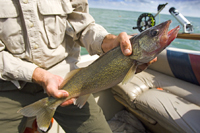A pair of UW-Extension researchers begin the long process of detailing the mineral and chemical composition of two of Wisconsin's largest rock units.
By Aaron R. Conklin
Among Wisconsin geologists, they’re known as the Wonewoc Formation and Tunnel City Group--rock units named for places in Wisconsin where they are well exposed and were first described. Yet these rocks underlie almost half of the state.
But these porous rock units present in areas of West and Central Wisconsin could also be a potential source of groundwater contaminants, including an extensive list of elements that includes everything from aluminum, arsenic and cadmium to cobalt, copper and lead.
With the support of funding from the Wisconsin Water Resources Institute (WRI), a team of University of Wisconsin- Extension researchers is taking the first of many steps to determine whether these formations are, in fact, a possible contamination source. They’re starting at the very beginning, creating a set of baseline data that details the mineral and chemical composition of the rocks.
“Wells in part of western Wisconsin drawing water from near the intersection of these formations sometimes have water chemistry that is not ideal,” said Jay Zambito, a bedrock geologist and professor with UW-Extension’s Wisconsin Geological and Natural History Survey and the principal investigator on the project. ”We sometimes find elements above advisory levels.”
To gauge the rock composition, Zambito and his colleague, hydrogeologist Mike Parsen, are collecting and studying rock samples, beginning with drill core, pristine rock materials collected from the subsurface across Wisconsin. Fortuitously, Wisconsin’s Geological and Natural History Survey curates and maintains an extensive library of drill cores. The collection contains cores from approximately 2,000 wells, as well as rock cuttings from another 11,000 water wells from across Wisconsin. This includes many samples from the Tunnel City and the Wonewoc rock units.
Having those samples available saves a ton of time—and a ton of cash.
“”It costs about $60-100 per foot to collect new drill core,” said Zambito, who noted that the estimated value of the drill core archive is between $120-140 million, though most is unique and irreplaceable. “Given the scope of this project, we’d be looking at spending approximately $2 million to collect these samples.”
Instead, they can get right to the research. Using an x-ray fluorescence analyzer, Zambito and Parsen will be able to quickly scan the cores and identify the elemental composition of the rock formations. Follow-up analyses will then be used to determine the minerals that contain these elements.
“This is a perfect example of a core being used for a different purpose than it was initially intended,” said Parsen.
Simple, right? Not quite: Just because an element is in a rock formation doesn’t mean it can leach into groundwater. A variety of environmental factors, including temperature, pH, oxygen levels, and whether the elements are incorporated within stable or unstable minerals, influences the process through which minerals can break down and constituent elements go into solution.
“We really don’t have a good idea whether these elements can make their way into the water,” explained Zambito. “That’s a subject for a subsequent study, after we figure out what elements and minerals are present.”
In addition to drill cores, Zambito and Parsen will also collect and analyze other samples, including freshly extracted rock from industrial sand mining operations and outcrops along the sides of highways.
Eventually, the results of Zambito and Parsen’s work could have the potential to inform policy decisions about where and how wells in West and Central Wisconsin that tap into the Tunnel City and Wonewoc rock units for water will be drilled and managed. Zambito pointed to an earlier WRI-funded study as a possible predictor, in which researchers determined that an interval of sulfide minerals found in the subsurface in the Green Bay area were breaking down and unleashing arsenic into the groundwater. The solution in that case could also be the solution in this case concerning the Tunnel City and Wonewoc rock units—casing-off groundwater wells so that water is not drawn from any possible horizons of problematic minerals.
“We would anticipate seeing geological layers that may contain lower or higher concentrations of problematic element-bearing minerals,” said Parsen. “The question becomes, how are we handling them? What’s the long-term policy?”
“Once we have that baseline data set, we’ll have a better idea about how to move forward in testing potential rock-to-groundwater geochemical pathways,” agreed Zambito. “This is really the first step.”

















